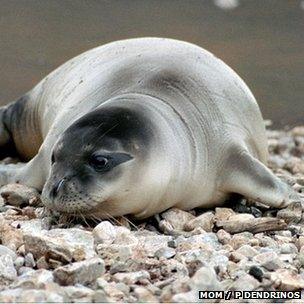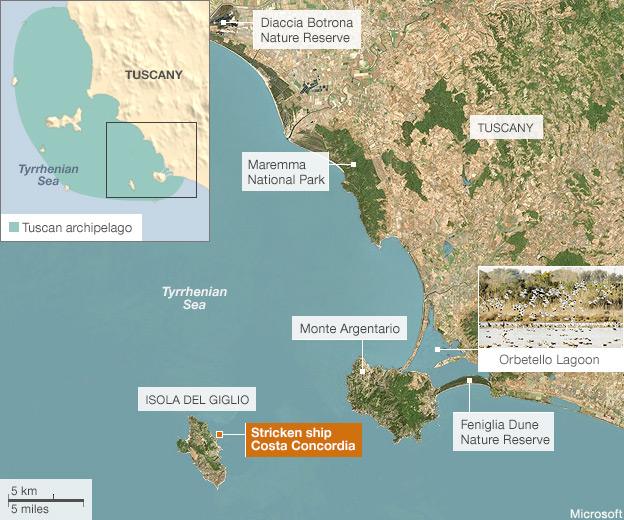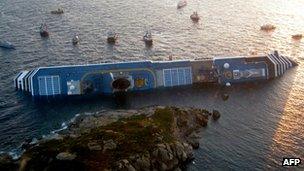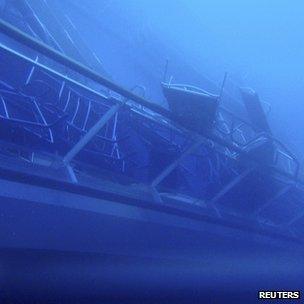Costa Concordia: An ecological disaster?
- Published
- comments

The critically endangered monk seal is a visitor to the Tuscan archipelago's waters
Even as the search continues for any further survivors of the Costa Concordia accident, questions are being asked about the potential environmental impact.
We have a big ship with tanks full of fuel, aground on an island in a sea fringed with natural protected areas.
So the worst case scenario is pretty bad.
Isola del Giglio, where the stricken cruise ship rests, is part of the Tuscan Archipelago National Park, external, the largest marine protected area in Italy.
Among its inhabitants are important plants and birds and some rare frogs, while the seas support coral, cetaceans and the occasional Mediterranean monk seal - a critically endangered species, external.
However, there is also quite a large human presence in the archipelago. On Giglio itself, external, only about half the land area is protected, and none of the seas around the shore.
Other islands further to the north and west - Elba, Pianosa, Montecristo - contain more natural riches.
To the east on the mainland, lies the Laguna di Orbetello, an important bird reserve.
A little further north is the Natural Park of Maremma, external - the only Italian habitat for at least one dune-dwelling plant, a stopover point for migratory birds, and the location for a successful reintroduction of osprey.

Elena Moutier, a scientific consultant working at the park, told BBC News that an oil spill there "would be a disaster".
"The Maremma Park is one of the most important regional parks in Italy, for the landscape, the ecosystem and the richness in endemic species of plants and animals," she said.
However, all of this is in the realms of the potential, not the actual.
As far as we are aware - and sources including the salvage company Smit and environmental group WWF concur - there has been no fuel spillage so far.

The ship lies close to shore, so any oil released could do major damage
There has been a fair amount of confusion about what material is on board, with some reports saying the Concordia runs on heavy fuel oil and others citing diesel.
That's a crucial point if there is a spill.
While relatively light diesel would disperse fairly quickly in a swelling sea, heavy fuel oil is clumpy and clinging, as we saw in the Deepwater Horizon disaster of 2010.
The answer is that the ship contains both. Smit's figures are 2,400 tonnes of heavy fuel oil and 200 tonnes of diesel; the manufacturer of the ship's engines told BBC News that they are "fuel flexible".
For comparison, said Simon Boxall from the UK's National Oceanography Centre, external, the fuel oil consignment is equivalent to "about half of a day's output" from the Deepwater Horizon disaster "when spewing oil at the full rate".
But the ship's proximity to the coast means a spill would be "damaging", he said.
Smit's experts and equipment are now in place near the stricken ship, and are ready to begin extracting the oil. The process involves drilling holes at the highest and lowest points of the tanks and fitting valves to them.
Seawater exerts pressure from the bottom, forcing the oil up and and out of the top valve. The sticky oil is encouraged to flow by using heat from a steam generator on a nearby barge.
The process could take two to four weeks.
The big risk in the meantime would be if the vessel began breaking up.

Contractors blasted holes in the hull to gain access, but overall it appears sound and stable
During a news conference on Tuesday morning, contractors were optimistic that it would not.
The seas are said to be calm; and although the Concordia is perched in coastal shallows with the potential to tumble into deeper waters, Smit believes it's unlikely to move.
"Based on the first underwater pictures, there are quite a number of [hull] penetrations on the starboard side," operations manager Kees van Essen told reporters.
"They are acting as an anchor; so although we never underestimate the danger, the chance of the vessel sliding down into deeper water is minimal."
In case of spillages in the meantime, the site is surrounded by booms - although as Deepwater Horizon proved, their utility as barriers can be substantially less than promised.
Perhaps the closest recent comparator is the Rena, the container ship that struck New Zealand's Astrolabe Reef in October.
Again, the site was in an area of outstanding ecological importance. And the pounding seas eventually broke the ship in two.
Nevertheless, the incident fell a long way short of constituting an environmental disaster - mainly because salvage operators were able to pump out the vast majority of the oil.
So far, the indications are that the Concordia may prove even less damaging - at least from an environmental point of view.
In both cases, there's a wider question. Neither vessel was on its scheduled course, for different reasons.
But parts of the Italian government and environment groups are asking whether such large vessels should be able to travel through, or even close to, areas that are supposed to be protected.
As Italy's Environment Minister Corrado Clini put it, referring to the passenger boats that ferry people around the Venetian lagoon: "That's enough, we have to stop treating these ships like they were simple vaporetti [small ferries]."
But cargo ships and cruise liners have commercial imperatives to go where they go. We will see whether Mr Clini wins the argument he is bound to have if he is serious about reining them in.